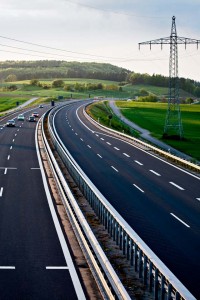Adrenalin shoots through the veins when you’re driving at 200 kph. Though nothing compares to speeding down the open autobahn like race car driver Michael Schumacher, it is also one of the leading causes of vehicle accidents in Germany.
In 2012, speeding was the cause of 6,587 accidents and 179 casualties on German autobahns. So, before enjoying a “Schumacher” moment on the German autobahn, it is vital to get informed.

German Autobahns
The first highway was built in Berlin between 1913 and 1921. Its 19 kilometers were initially used for races only. The idea was to create a road without intersections or oncoming traffic.
The first public autobahn in that sense connected the cities of Cologne and Bonn. In order to use them as quick transportation connections, Adolf Hitler created a network of more than 2,000 kilometers of highways. Today, Germany has one of the densest webs of highways in the world at about 12,845 kilometers.
Officially, freeways here are called “Bundesautobahn,” or federal freeways. Bundesautobahn, or BAB for short, are only for vehicles with a minimum top speed of more than 60 kph.
The Need For Speed
Despite its reputation of unhindered freedom, many sections of the autobahn do have speed limits, and police usually enforce these limits by installing either temporary or permanent radar speed controls.
Though certain sections of autobahn may not have a speed limit, all highways have a “Richtgeschwindigkeit,” or recommended speed limit, of 130 kph.
In this case, speeding faster than 130 kph won’t get you a ticket, however, guilt can be determined if speeding is found to be a factor in an accident. The federal state of Bremen, for example, introduced a general speed limit of 120 kph on all of its freeways in April 2008.
Small, round signs on the back of certain vehicles, such as busses or trucks, that display 80 or 100 indicate this vehicle is only allowed to drive at that maximum speed. Caravans and mobile homes are also limited to 80 kph unless they have an exceptional permit to go 100 kph.
The Numeral System
BABs are ordered in a numeral system. Those going north-south have ungraded figures, and east-west have graded. Autobahns with only one digit (A1 to A 9) go farther distances through the country. Double digits (A10 up to A99) are assigned to specific regions. For example, A60 and higher are found in the area of Rheinland-Pfalz, Saarland and Südhessen.
Autobahns with three digits usually connect or lead to larger highways.
The Dreaded ‘Stau’
According to the German Federal Office for Motor Traffic (KBA), there are 60.8 million vehicles registered in Germany. That makes 640 vehicles for 1,000 people. So, talking about the autobahn also means talking about the “stau,” or traffic jam.
So, what should motorists do if they find themselves in a traffic jam? Some drivers take the next exit to circumnavigate the problem area on country roads. Others prefer to stay on the freeway, because it is usually the shortest connection between two points.
Traffic expert Jürgen Grieving from the German Automobile Club ADAC said it really depends on the situation.
“Is it a complete closure or just a few kilometers of congestions? Do you really know the area and some good rat runs? Detours on unknown country roads usually don’t pay but take much more time,” he said.
“So, my best advice is really to always prepare your trip properly beforehand. Look at the maps and the route you want to take, find out about potential construction areas, and 15 minutes before you leave, check the current situation via the web, congestion apps or a TMC navigation system.”
Other Things To Keep In Mind
While on the autobahn in Germany, it is also important to remember that passing on the right is strictly prohibited. If you are driving the slower vehicle, you must move to the right to allow faster traffic to pass.
If you don’t move over, expect to have the motorists behind you flash their high beams, switch on their left indicator light or tailgate you, even though these options are not legal and not encouraged.
Passing on the right is only acceptable while in the acceleration lane for entering the freeway.
However, while entering you do not have the right of way, so be cautious. As the outer left lane is for the fast moving traffic, logically, if you are pulling a trailer you have to stay out of that lane. When emergency vehicles make their way through congestion, motorists must create a gap between the lanes.
In Case Of Emergency
If you are involved in an accident, turn on the emergency flashing lights, put on a safety vest, exit the vehicle carefully, and get all
passengers on the shoulder behind the guard rail. Make sure to also place a warning triangle 200 meters behind the accident. A call to authorities should be made immediately.
Avoid The Fines
Sticking to the law shouldn’t be difficult, especially when faced with the alternatives: fines and other driving restrictions.
• If caught driving too fast in an area with a speed limit, fines range from €10 to €375.
• If you exceeded the limit by 41 or more kph, your license can be taken away for a month or longer.
• Tailgating can also lead to a temporary loss of driving privileges.







